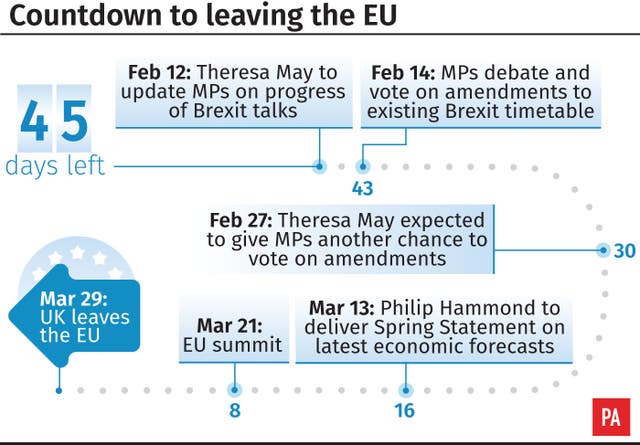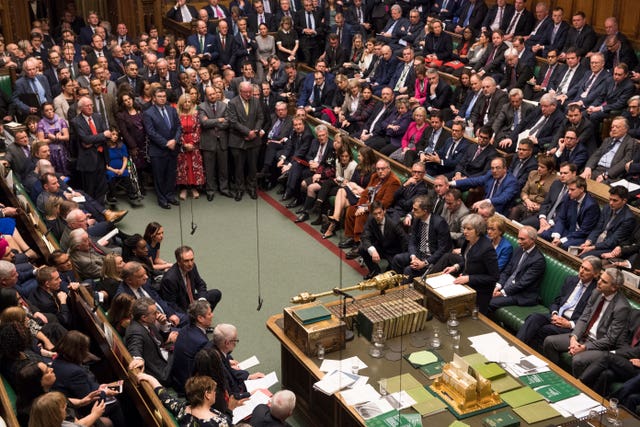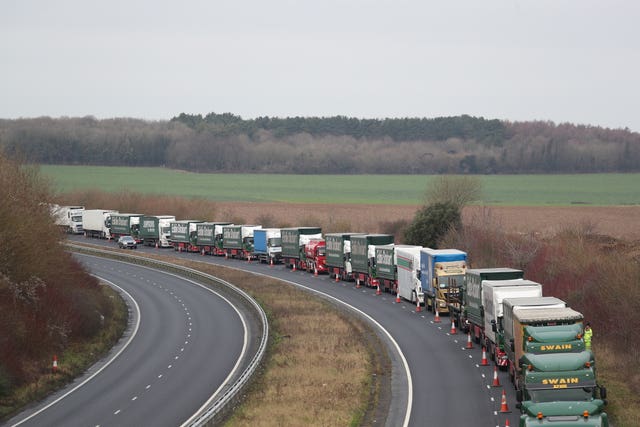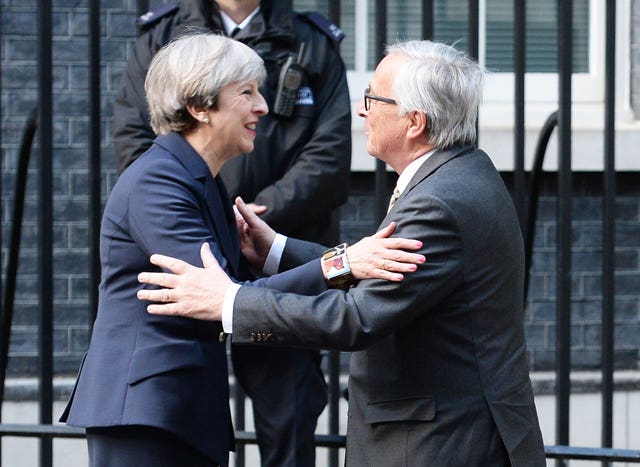What’s next for Brexit as Leave date looms?
With just 45 days to go, many questions about the UK’s withdrawal from the EU remain unresolved.

With 45 days to the scheduled date of Brexit, voters might have expected everything to be sorted out by now. Not so. Here are some of the questions still being asked:
So what’s the plan?
No-one knows. Less than seven weeks before the biggest constitutional upheaval in decades, there is no clear majority in the Commons for any plan. The Plan B put forward by Theresa May seems barely altered from the Withdrawal Agreement rejected by 230 votes last month. And there is little sign that the EU is ready to accept the changes Mrs May is seeking. Meanwhile, alternative plans struggle to get off the ground.

What’s the big sticking point?
Mrs May wants changes to the proposed “backstop” to keep the Irish border open after Brexit. The EU insists the arrangement – under which the UK remains in a customs union until a wider trade deal is agreed – is needed as insurance to stop unwanted goods like GM crops flooding into the European market. But many Tories hate the idea, which leaves the UK being indefinitely stuck with EU rules and unable to strike trade deals or to leave without Brussels’ say-so.
So what can be done about it?
Mrs May wants a time-limit or unilateral right to leave the backstop, or a technological scheme to monitor border crossings without the need for guards wielding rubber stamps. Brussels is hinting it could beef up its letter of reassurance that it will end the backstop as soon as possible. But this is not enough for many Brexit-backing MPs, who want it erased from the Withdrawal Agreement altogether.

How else is the PM trying to build support?
Mrs May has reached out to potential Labour backers by offering protections for workplace and environmental rights and regeneration money for “left-behind” areas post-Brexit. When Jeremy Corbyn came up with five demands for Labour support, the PM didn’t dismiss it out of hand, but offered talks.
So could Tories and Labour come together behind a Brexit deal?
Difficult to envisage. Many details of Mr Corbyn’s plan are toxic to Tories, such as permanent membership of a customs union and close alignment with the single market. Mrs May might hope to win a Commons majority by reaching across the floor, but she risks splitting her party.
And are Labour people happy with this?
Many Labour MPs are frustrated with their leader’s stance. While a lot of the party’s constituencies in the Midlands and North voted Leave in 2016, most of its actual voters and an overwhelming majority of members support Remain. A conference motion keeping a second referendum on the table gave them hope that Mr Corbyn would eventually swing behind calls for a “People’s Vote”. Some now fear he will never do this, while others think he is leaving it very late.
So what happens next?
Mrs May’s statement to MPs on February 12 was never expected to move matters forward much. And a Valentine’s Day vote in the Commons now looks unlikely to prove conclusive. MPs can table and vote on amendments demanding anything from an end to the backstop to a delay to Brexit or a second referendum. But Mrs May has neutralised the potential flashpoint by announcing another debate on February 27. And even after that, she has promised a final vote on whatever deal she gets from Brussels, kicking the can further down the road. Any ministers thinking of resigning or backbenchers mulling rebellion know this is not their last chance, and may decide to give the PM another fortnight before making a stand.
What if there’s no agreement by March 29?
Under the Article 50 process, the default is for the UK to simply leave without a deal. This means falling back on global trade rules imposing tariffs on many products. The UK would also drop out of many agreements which smooth everyday activities like taking a flight, making electronic payments or using a phone overseas. No doubt fixes would be found to keep planes flying and ships sailing. But business groups warn that extra bureaucracy, costs and queues at ports could force many firms to close, while experts warn of empty supermarket shelves and medicine shortages. Brexiteers insist the EU also has a lot to lose and can be expected to give way on key demands rather than face economic chaos.

So is this becoming a giant game of chicken?
That’s increasingly how it looks. Observers suspect the PM of relying on the looming spectre of no-deal to bring rebel Tories into line and win the reluctant support of Labour MPs fearing for jobs and livelihoods. And they think that Mrs May is counting on Brussels to back down as individual countries like Germany and Italy start seriously worrying about losing a chunk of the British export market for their cars or wine. So far, the EU27 have held firm in support of Ireland behind the backstop deal. If neither side blinks, no-deal may be the result.
Isn’t time running out to get everything done?
Yes. Even if a deal is agreed and approved by the Commons – and the European Parliament – the Government has to pass legislation to implement it, along with a series of other bills governing post-Brexit policy on immigration, trade, fisheries, agriculture, healthcare and financial services. Under normal procedures, it is already too late to get them through Parliament before March 29. They could be rushed through using emergency methods, but that would rely on MPs offering no resistance.
Is there any other way of avoiding no-deal?
Yes. Right up to the last minute, Mrs May has the option of revoking the UK’s notice of intention to leave, without requiring approval from Brussels. This is something she has vowed never to do. She can also request an extension to the Article 50 process, which needs unanimous approval from the EU27. They have hinted this could be done to allow time for a referendum or election, but are reluctant to go beyond the European Parliament elections at the end of May.
Can MPs force Mrs May’s hand?
It’s possible. A variety of schemes to put Parliament in control were defeated last month, but could be resurrected in upcoming votes. There is little doubt that a majority against no-deal exists in Parliament, and several ministers have indicated they could resign to help stop it. But a motion rejecting no-deal passed by the Commons on January 29 is not binding on the Prime Minister. Supporters of a second referendum are holding back until all other options are exhausted, in order to avoid accusations of trying to sabotage a viable Brexit. But momentum behind a People’s Vote may be flagging, with polls showing only a relatively slim majority for Remain, rather than the decisive shift which would force politicians to respond.

So when will we know what’s going to happen?
Mrs May and European Commission president Jean-Claude Juncker have promised to meet again before the end of February, but there’s no guarantee that this will produce a conclusion. Some are now looking to the European Council summit of March 21-22 – just a week before Brexit day – to deliver a last-minute compromise. Negotiations involving the EU tend to go down to the wire, but the stakes have never been so high and the demand for certainty so urgent.





